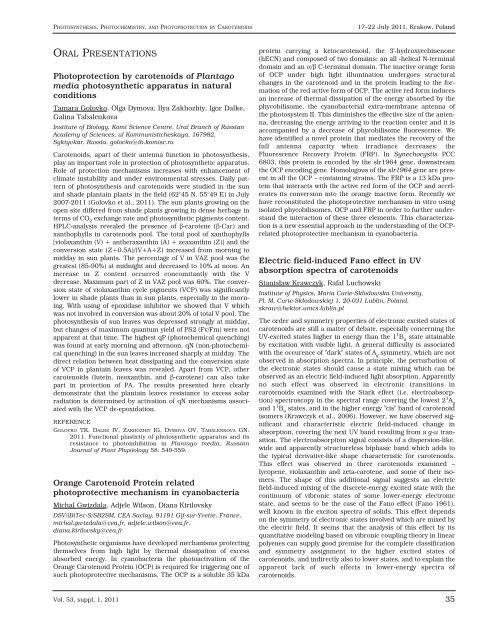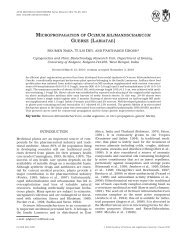ACTA BIOLOGICA CRACOVIENSIA
ACTA BIOLOGICA CRACOVIENSIA
ACTA BIOLOGICA CRACOVIENSIA
Create successful ePaper yourself
Turn your PDF publications into a flip-book with our unique Google optimized e-Paper software.
PHOTOSYNTHESIS, PHOTOCHEMISTRY, AND PHOTOPROTECTION BY CAROTENOIDS<br />
ORAL PRESENTATIONS<br />
Photoprotection by carotenoids of Plantago<br />
media photosynthetic apparatus in natural<br />
conditions<br />
Tamara Golovko, Olga Dymova, Ilya Zakhozhiy, Igor Dalke,<br />
Galina Tabalenkova<br />
Institute of Biology, Komi Science Centre, Ural Branch of Russian<br />
Academy of Sciences, ul Kommunisticheskaya, 167982,<br />
Syktyvkar, Russia, golovko@ib.komisc.ru<br />
Carotenoids, apart of their antenna function in photosynthesis,<br />
play an important role in protection of photosynthetic apparatus.<br />
Role of protection mechanisms increases with enhancement of<br />
climate instability and under environmental stresses. Daily pattern<br />
of photosynthesis and carotenoids were studied in the sun<br />
and shade plantain plants in the field (62°45 N, 55°49 E) in July<br />
2007-2011 (Golovko et al., 2011). The sun plants growing on the<br />
open site differed from shade plants growing in dense herbage in<br />
terms of CO 2 exchange rate and photosynthetic pigments content.<br />
HPLC-analysis revealed the presence of β-carotene (β-Car) and<br />
xanthophylls in carotenods pool. The total pool of xanthophylls<br />
[violaxanthin (V) + antheraxanthin (A) + zeaxanthin (Z)] and the<br />
conversion state (Z+0.5A)/(V+A+Z) increased from morning to<br />
midday in sun plants. The percentage of V in VAZ pool was the<br />
greatest (85-90%) at midnight and decreased to 10% at noon. An<br />
increase in Z content occurred concomitantly with the V<br />
decrease. Maximum part of Z in VAZ pool was 60%. The conversion<br />
state of violaxanthin cycle pigments (VCP) was significantly<br />
lower in shade plants than in sun plants, especially in the morning.<br />
With using of epoxidase inhibitor we showed that V which<br />
was not involved in conversion was about 20% of total V pool. The<br />
photosynthesis of sun leaves was depressed strongly at midday,<br />
but changes of maximum quantum yield of PS2 (Fv/Fm) were not<br />
apparent at that time. The highest qP (photochemical quenching)<br />
was found at early morning and afternoon. qN (non-photochemical<br />
quenching) in the sun leaves increased sharply at midday. The<br />
direct relation between heat dissipating and the conversion state<br />
of VCP in plantain leaves was revealed. Apart from VCP, other<br />
carotenoids (lutein, neoxanthin, and β-carotene) can also take<br />
part in protection of PA. The results presented here clearly<br />
demonstrate that the plantain leaves resistance to excess solar<br />
radiation is determined by activation of qN mechanisms associated<br />
with the VCP de-epoxidation.<br />
REFERENCE<br />
GOLOVKO TK, DALKE IV, ZAKHOZHIY IG, DYMOVA OV, TABALENKOVA GN.<br />
2011. Functional plasticity of photosynthetic apparatus and its<br />
resistance to photoinhibition in Plantago media. Russian<br />
Journal of Plant Physiology 58: 549-559.<br />
Orange Carotenoid Protein related<br />
photoprotective mechanism in cyanobacteria<br />
Michal Gwizdala, Adjele Wilson, Diana Kirilovsky<br />
DSV/iBiTec-S/SB2SM, CEA Saclay, 91191 Gif-sur-Yvette, France,<br />
michal.gwizdala@cea.fr, adjele.wilson@cea.fr,<br />
diana.kirilovsky@cea.fr<br />
Photosynthetic organisms have developed mechanisms protecting<br />
themselves from high light by thermal dissipation of excess<br />
absorbed energy. In cyanobacteria the photoactivation of the<br />
Orange Carotenoid Protein (OCP) is required for triggering one of<br />
such photoprotective mechanisms. The OCP is a soluble 35 kDa<br />
Vol. 53, suppl. 1, 2011<br />
17–22 July 2011, Krakow, Poland<br />
protein carrying a ketocarotenoid, the 3'-hydroxyechinenone<br />
(hECN) and composed of two domains: an all -helical N-terminal<br />
domain and an α/β C-terminal domain. The inactive orange form<br />
of OCP under high light illumination undergoes structural<br />
changes in the carotenoid and in the protein leading to the formation<br />
of the red active form of OCP. The active red form induces<br />
an increase of thermal dissipation of the energy absorbed by the<br />
phycobilisome, the cyanobacterial extra-membrane antenna of<br />
the photosystem II. This diminishes the effective size of the antenna,<br />
decreasing the energy arriving to the reaction center and it is<br />
accompanied by a decrease of phycobilisome fluorescence. We<br />
have identified a novel protein that mediates the recovery of the<br />
full antenna capacity when irradiance decreases: the<br />
Fluorescence Recovery Protein (FRP). In Synechocystis PCC<br />
6803, this protein is encoded by the slr1964 gene, downstream<br />
the OCP encoding gene. Homologous of the slr1964 gene are present<br />
in all the OCP – containing strains. The FRP is a 13 kDa protein<br />
that interacts with the active red form of the OCP and accelerates<br />
its conversion into the orange inactive form. Recently we<br />
have reconstituted the photoprotective mechanism in vitro using<br />
isolated phycobilisomes, OCP and FRP in order to further understand<br />
the interaction of these three elements. This characterization<br />
is a new essential approach in the understanding of the OCPrelated<br />
photoprotective mechanism in cyanobacteria.<br />
Electric field-induced Fano effect in UV<br />
absorption spectra of carotenoids<br />
Stanisław Krawczyk, Rafał Luchowski<br />
Institute of Physics, Maria Curie-Skłodowska University,<br />
Pl. M. Curie-Skłodowskiej 1, 20-031 Lublin, Poland,<br />
skraw@hektor.umcs.lublin.pl<br />
The order and symmetry properties of electronic excited states of<br />
carotenoids are still a matter of debate, especially concerning the<br />
UV-excited states higher in energy than the 1 1 B u state attainable<br />
by excitation with visible light. A general difficulty is associated<br />
with the occurence of "dark" states of A g symmetry, which are not<br />
observed in absorption spectra. In principle, the perturbation of<br />
the electronic states should cause a state mixing which can be<br />
observed as an electric field-induced light absorption. Apparently<br />
no such effect was observed in electronic transitions in<br />
carotenoids examined with the Stark effect (i.e. electroabsorption)<br />
spectroscopy in the spectral range covering the lowest 2 1 A g<br />
and 1 1 B u states, and in the higher energy "cis" band of carotenoid<br />
isomers (Krawczyk et al., 2006). However, we have observed significant<br />
and characteristic electric field-induced change in<br />
absorption, covering the next UV band resulting from a g-u transition.<br />
The electroabsorption signal consists of a dispersion-like,<br />
wide and apparently structureless biphasic band which adds to<br />
the typical derivative-like shape characteristic for carotenoids.<br />
This effect was observed in three carotenoids examined –<br />
lycopene, violaxanthin and zeta-carotene, and some of their isomers.<br />
The shape of this additional signal suggests an electric<br />
field-induced mixing of the discrete-energy excited state with the<br />
continuum of vibronic states of some lower-energy electronic<br />
state, and seems to be the case of the Fano effect (Fano 1961),<br />
well known in the exciton spectra of solids. This effect depends<br />
on the symmetry of electronic states involved which are mixed by<br />
the electric field. It seems that the analysis of this effect by its<br />
quantitative modeling based on vibronic coupling theory in linear<br />
polyenes can supply good premise for the complete classification<br />
and symmetry assignment to the higher excited states of<br />
carotenoids, and indirectly also to lower states, and to explain the<br />
apparent lack of such effects in lower-energy spectra of<br />
carotenoids.<br />
35












